The next mood shift
Foreword
World peace is in jeopardy, Trump II looms and interest rates are not falling as quickly as investors expected. But stock prices are up and capital market volatility has been low this year. How does that work?
Financial markets are impersonal, and in fact often seem indifferent to geopolitical concerns – a point we’ve made before. But their failure to be significantly affected by the further re-think on interest rates is perhaps a little more unusual.
We have always felt that a big economic setback was neither necessary nor likely. Still, the consensus has embraced a “soft landing” remarkably firmly of late. It would be surprising if this mood persists – not because economic drama is inevitable, but because sentiment is fickle. Data rarely travel in straight lines, and pundits must be itching to extrapolate the next outlier when it arrives.
One potential scare might be triggered by an inflation or activity indicator surprising significantly to the upside, leading to expectations that rates might be higher for even longer, or indeed even higher for even longer (more rate hikes are always possible). In the other direction, growth pessimism is perennial, waiting to be rekindled by a weak outturn, or as the ultimate outcome of the “higher for even longer” scare. So too is the stagflation scenario (no growth, but more inflation).
In the investment context, then, it has felt as if it’s a little “too quiet out there”. It may not be the best time to add further to tactical positions in securities. But if we’re right, and economic drama – slump, revived inflation, or both – can indeed be avoided, then the appropriate response to a mood-swing and revived volatility now might be to seek opportunities. And with bonds looking reasonably valued for the first time in many years, prospects may no longer be confined to equity markets.
In this issue of Market Perspective, alongside the usual cyclical update and inflation watch, we also ask just how worried we should be by rising US government debt.
Kevin Gardiner / Victor Balfour / Anthony Abrahamian
Global Investment Strategists
Cyclical update: even longer – even higher?
Overview: rate cuts postponed, not cancelled (probably)
US inflation has again been a little higher than expected (as usual we review the latest inflation data below). It does not materially alter the big cyclical picture as we see it, which is one of ongoing economic resilience alongside gradual disinflation.
Resilience, but not a boom: economic growth even in the US is not yet prospectively strong enough to warrant higher interest rates or a big upgrade to expected corporate earnings, though it could become so (see below).
And gradual disinflation, not deflation: wages, the key driver of much sticky service-sector inflation, are continuing to slow, promising some resumed slowing in the Consumer Price Index (CPI) in months ahead – but on a smaller scale than what has already taken place (arithmetically there isn’t that much downside anyway). We do not see 2% targets (which in the US technically applies to Personal Consumption Expenditure inflation, not the CPI) being sustainably achieved for a year or two, but instead have been expecting US and European (UK included) inflation rates to slowly bottom out and settle in the 2-4% region.
At the margin, the March outturn does make the Fed even less likely to be in a rush to cut interest rates – but it is not the first piece of news to do so of late.
So: interest rates globally probably still are turning a corner, but continue to do so more slowly than money markets have been expecting – and much more slowly than inflation, which has now made its big move.
Let’s take a moment
We should take a moment to put this in perspective. Since early 2022, we have collectively been on recession watch as pundits have queued up to predict an imminent and meaningful downturn. We have commented on how in the UK at least the public mood for much of the time has been one of barely-suppressed economic hysteria. In the event, there have been technical recessions – early on in the US, and more recently in the UK – but nothing close to the downturns envisaged by many (including, here, the Bank of England, with its “longest post-war” recession forecast). Western unemployment has stayed low throughout. And in the last year, the most widely-watched and influential economy of all, the US, has actually grown more quickly than it usually does.
Meanwhile, confident proclamations of a new inflationary age seem also to have been premature. There has been no “wage-price spiral”, and the post-pandemic inflation surge currently looks unlikely to register on the long-term charts: it is not a “sixth wave”.
This doesn’t let central banks off the hook: they may not have lost much on their bet, but that doesn’t make monetary gambling a good thing. Credibility has to be rebuilt – which means that the bar for monetary easing has been set higher in most circumstances. In other words, it’s not just about the data: across a wide range of scenarios, the need to rebuild monetary credibility argues for a slower reduction in rates – even if unemployment does start to rise more meaningfully – than would have been the case had policy been more credible throughout.
Monetary risk is one-sided. There have been no hyperdeflations, and policy stances need to reflect that more visibly than they did in late 2021, for example, when central banks allowed historically-low interest rates to coincide with historically-low unemployment.
The usual caveat applies: we are not out of the woods yet. But forward-looking business surveys seem to be stabilising, with highly cyclical manufacturing sentiment in particular picking up a little. Two prominent headwinds have eased and started to reverse: European energy costs have fallen sharply with natural gas prices, allowing real wages to rebound even as nominal pay growth slows, and interest rates have stopped rising (at least for now, and in nominal terms) and seem likely to fall – eventually (Figure 1). And consensus opinion may be too pessimistic on trend growth to begin with (perhaps because it persists in viewing pre-2007 trends as being sustainable). 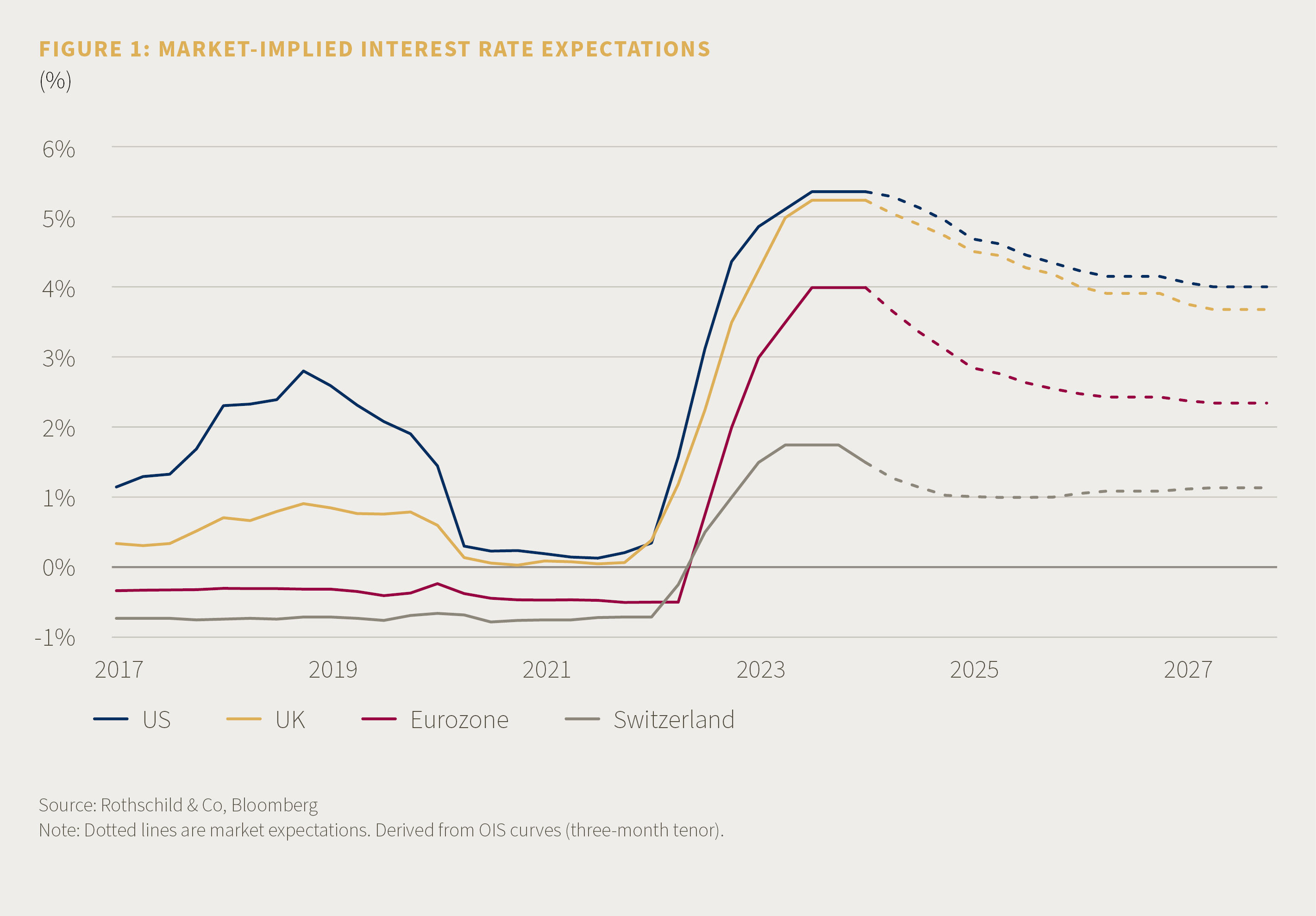
Even longer – even higher?
Policy rates had already been significantly “higher for longer” than the consensus initially expected when they started to rise in late 2021/early 2022, and the US CPI data underscores that they are likely to be higher for even longer. And as noted above, they might yet turn out to be even higher for even longer. In other words: they may not have peaked definitively. That is not our call, but it is important to acknowledge the possibility: there are few imperatives in finance. If rates were to rise even further, stock markets would surely sit up and take more notice, and we could expect the predictions of economic slump to re-emerge with a vengeance (though not necessarily with any greater accuracy…).
The money markets started the year pricing-in around seven 25 basis point (1/4 percentage point) rate cuts from the big three Western central banks in 2024. That number has now dropped to just two from the Federal Reserve (Fed) and Bank of England (BoE), and three from the European Central Bank (ECB).
Much is being made of the prospect of divergent monetary policies – particularly if, as seems likely, the ECB and BoE move before the Fed – but the scale of the likely divergence looks unremarkable, and economically insignificant (even if a softer euro and pound were to amplify the impact – which, incidentally, would reduce the attractiveness of the “bunds over Treasuries” trade to private client portfolios).
None of this argues yet in favour of taking investment risk off the table. But it does suggest keeping both bond optimism, and overall macro risk appetite, in check.
Monetary risk is one-sided. There have been no hyperdeflations, and policy stances need to reflect that more visibly than they did in late 2021…
EXCEPTIONS WHICH PROVE THE RULE?
There have been some high profile exceptions to the “higher for longer” monetary trend. What the cases below perhaps have in common is the absence of a significant inflation threat to begin with.
Most notably perhaps the Swiss National Bank (SNB) broke Western ranks with a 25 basis point (bp) rate cut in March, to 1.5%. We did not expect the move, but were not hugely surprised by it – and neither were the local capital markets, to judge by the response.
Across a wide range of indicators, Switzerland was the best-performing developed economy in the scorecard we produced last May. Swiss inflation peaked at just 3.5% in August 2022, and is currently at 1%. Until the New Year, the franc had been trending higher, arguably adding to the monetary tightening delivered by the SNB’s cumulative 250 bp hike in rates. The SNB’s credibility has not been in doubt to begin with. Of course, a small federal government and sound money alone are not necessarily attractive to equity investors…
The franc has now fallen back from its trade-weighted peak, reintroducing some uncertainty, and restraining the sort of potentially destabilising inflows we have seen in the past.
The Bank of Japan broke ranks in the other direction – or was it belatedly catching-up with what the rest have been doing? – by raising rates from -10 bp to 0-10 bp, its first move since early 2016, and its first hike since early 2007. It brings to an end the last negative policy rate still in place.
To be fair, in not raising rates earlier it had not damaged its credibility, because (as with the SNB) there has been little local inflation: after two decades of deflation (to 2020), it rose to peak at just 4.3% in early 2023.
We don’t often comment on Japan, but its economy and bond market are a preoccupation for many pundits – a focus out of all proportion to their investment importance. Arguably, economists should have been talking not so much about the “Japanification” (awful word) of the West, but about the likely “Westernisation” of Japan…
It was never clear why a few basis points on the local side of a supposedly popular international carry trade should have more impact on flows than hundreds of basis points on the other side. The lack of a wider response to this supposedly epochal event is not surprising.
Japan’s economy is unique, not being conventionally capitalist to begin with, and its reported struggles with a supposed “balance sheet recession” (awful phrase) have surely reflected local idiosyncrasies rather than some yet-to-be-discovered general law. Those struggles have seen it actively pursuing more inflation, and the rate remains above the Bank of Japan’s long-standing objective of 2%.
As they say, be careful what you wish for. As yet, though, as noted, Japan’s monetary credibility – despite its gyrating exchange rate – remains intact. And while Japan may have been largely marking time in recent years, it is still a relatively prosperous, and socially at-ease, country. Whatever may be wrong with its economy, we doubt it has much to do with the earlier deflation, which looks economically and statistically insignificant (it is within the realm of measurement error).
Finally, the People’s Bank of China may not have been in action of late, but it has been effectively loosening policy for several months – mostly by cutting required levels of bank reserves, but also by trimming key policy rates. As with the SNB and Japan, it has been able to plough its own monetary furrow because its inflation cycle has been so benign.
Ongoing monetary loosening may yet support the local economy stock market – the jury is still out – but we no longer carry a top-down torch for that. It is more likely to help the bond market, but as with Japan, that is a long way to travel (in terms of risk, not kilometres) for such a small yield.
Inflation: the last mile?
Inflation has fallen a long way across the US and Europe.
US inflation is now in the 3-4% range, while eurozone data are even closer to central banks’ 2% targets, in the 2-3% region. Switzerland’s inflation remains remarkably subdued – allowing the Swiss National Bank to begin its easing cycle, as noted – and, at the time of writing, UK inflation seems poised to fall sharply next month with the energy price cap’s latest decline.
As Figure 2 shows, headline inflation rates were a multiple of today’s levels at their peak, while core inflation readings were almost double their current rates.
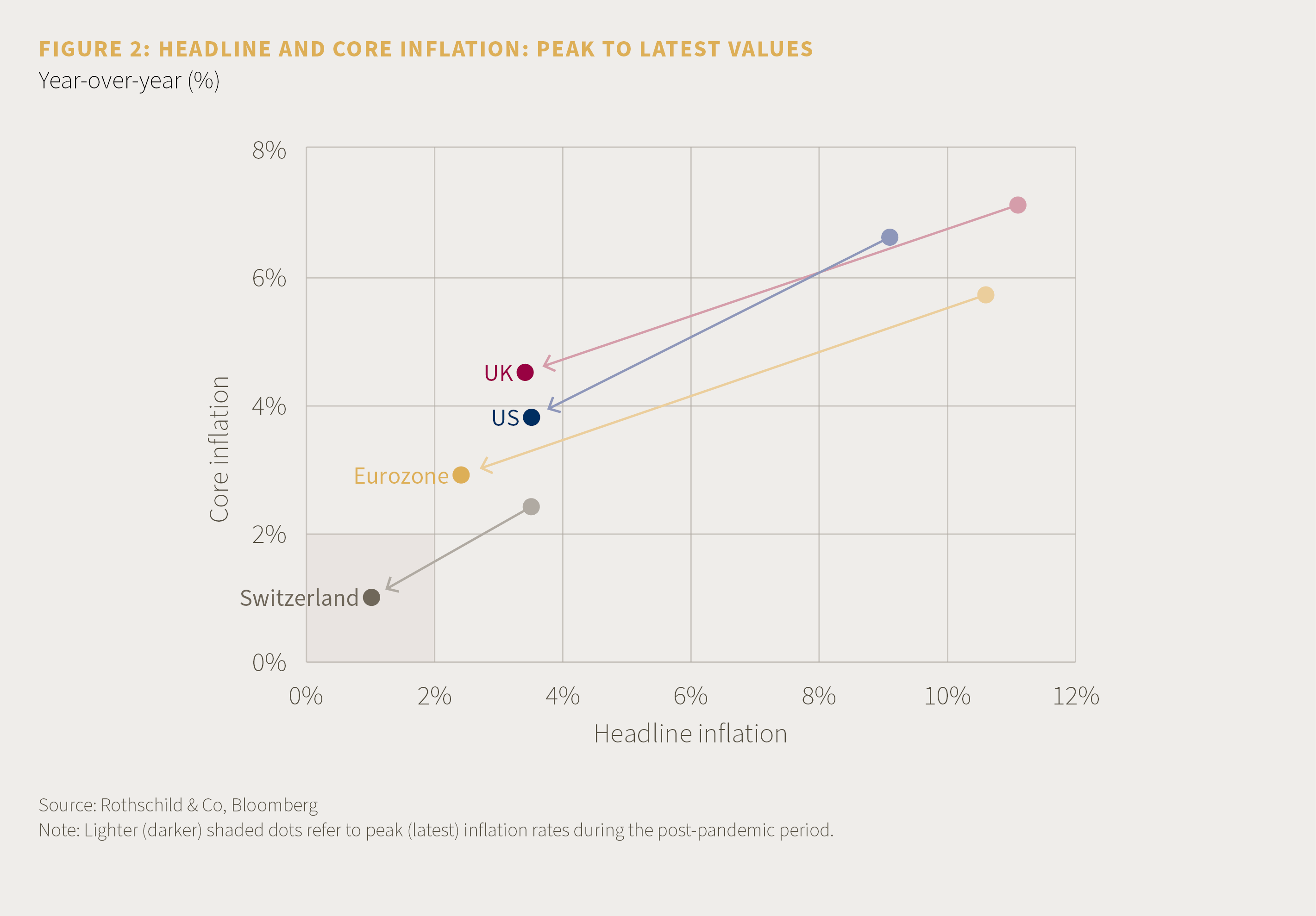 But do we now face the last mile? To answer this question, we examine the four main categories of Consumer Price Indices (CPI) below, namely: energy, food, goods and services – of which the latter two groups comprise the so-called “core”.
But do we now face the last mile? To answer this question, we examine the four main categories of Consumer Price Indices (CPI) below, namely: energy, food, goods and services – of which the latter two groups comprise the so-called “core”.
Oil’s revival: a manageable risk?
Energy CPI inflation, the most volatile category, has been a hot topic since our last edition of Market Perspective.
Brent Crude – the global oil benchmark – has risen by nearly a fifth this year, recently exceeding $90 per barrel. Like most commodity prices, it is difficult to disentangle its drivers. But it is probably linked to a mix of robust demand and supply uncertainty, amid geopolitical tensions and OPEC+ production cuts. That said, the price of oil remains within recent trading ranges, and absent another negative supply shock – which, admittedly, cannot be completely ruled out given the recent escalation in the Middle East – a more dramatic move higher seems unlikely.
In the US, gasoline prices are highly sensitive to changes in the crude benchmark, and so rising oil prices have already filtered through to the energy CPI basket (Figure 3). The year-over-year change in gasoline prices – the price today relative to one year ago – has turned positive again, and energy CPI inflation is subsequently no longer deflationary. However, as mentioned above, a renewed surge in overall inflation seems unlikely, given that current gasoline prices are similar to last year’s average (for context, the energy component of US CPI only accounts for 7% of the overall basket).
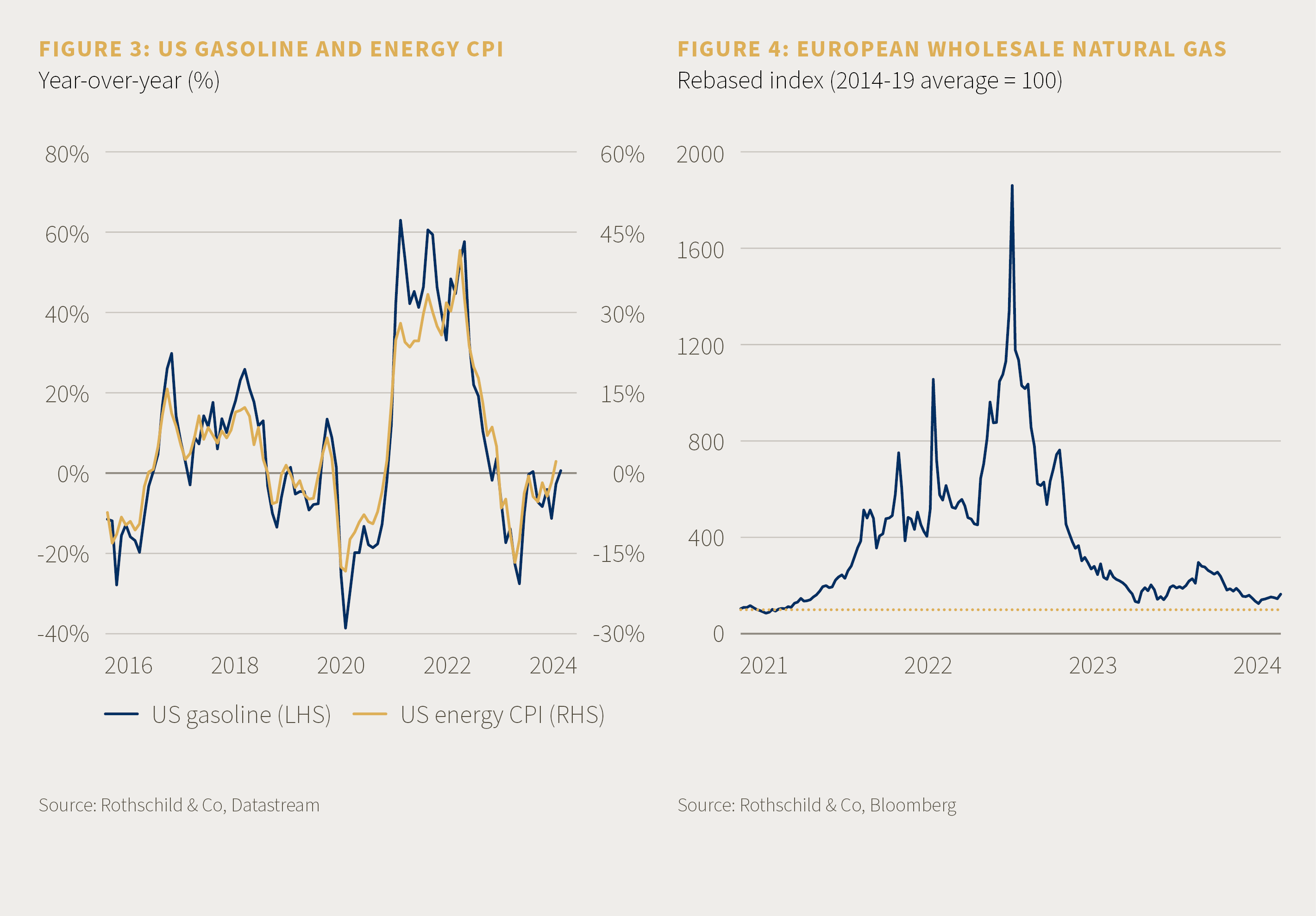
On the other side of the Atlantic, Europe’s energy backdrop remains more benign. Wholesale natural gas prices, which rocketed in the aftermath of Russia’s invasion of Ukraine, are currently at one-tenth of those highs (Figure 4), though still above pre-pandemic levels. Various governments’ energy price caps are still catching up with this decline (for example, in the UK), and there are probably more energy-driven declines in European inflation rates ahead. (US natural gas prices are flirting with three-decade lows, but they carry less weight in their respective CPI basket).
Food CPI inflation is the other non-core component. Wholesale food prices have been falling for two years at the global level, and so we should continue to see ongoing disinflation in US and European food CPIs. There are of course other costs contributing to the prices we see on supermarket shelves, but the price of the primary commodity itself is still falling.
Ongoing supply chain resilience
Goods CPI inflation, the third major component, has mostly normalised in both the US and Europe (it is in fact deflationary – prices have actually been falling, not just slowing – in the former). That said, two potential headwinds have moved into focus.
The first, supply-related risk is ongoing trade disruption in the Red Sea, which may bring back memories of the colossal disruption witnessed during the pandemic. The impact of the latest shock has so far been limited, however. The New York Fed’s Supply Chain Index suggests “normal” conditions (Figure 5), while global shipping costs have been falling in recent months. Moreover, the latter only rose to a third of their 2021 high, which suggests the demand-supply imbalance – if any – was much smaller this time. Supply chains have so far been stretched, not broken.
The second, demand-side risk relates to the global manufacturing cycle, which appears to have turned higher again. Industrial commodity prices, such as metals, have risen, which could indirectly affect goods CPI inflation as producers pass on some of these higher costs to consumers. Even so, this is unlikely to threaten the goods CPI narrative too much. For one thing, manufacturing demand is much weaker than it was in the aftermath of the pandemic. And the recent rebound in industrial metal prices has been modest, remaining well below their 2022 high.
While most of the supply-driven decline in goods inflation may have now occurred, it seems unlikely to significantly ratchet up from here either. Although, as with our interest rate comments above, a renewed surge must always be possible.
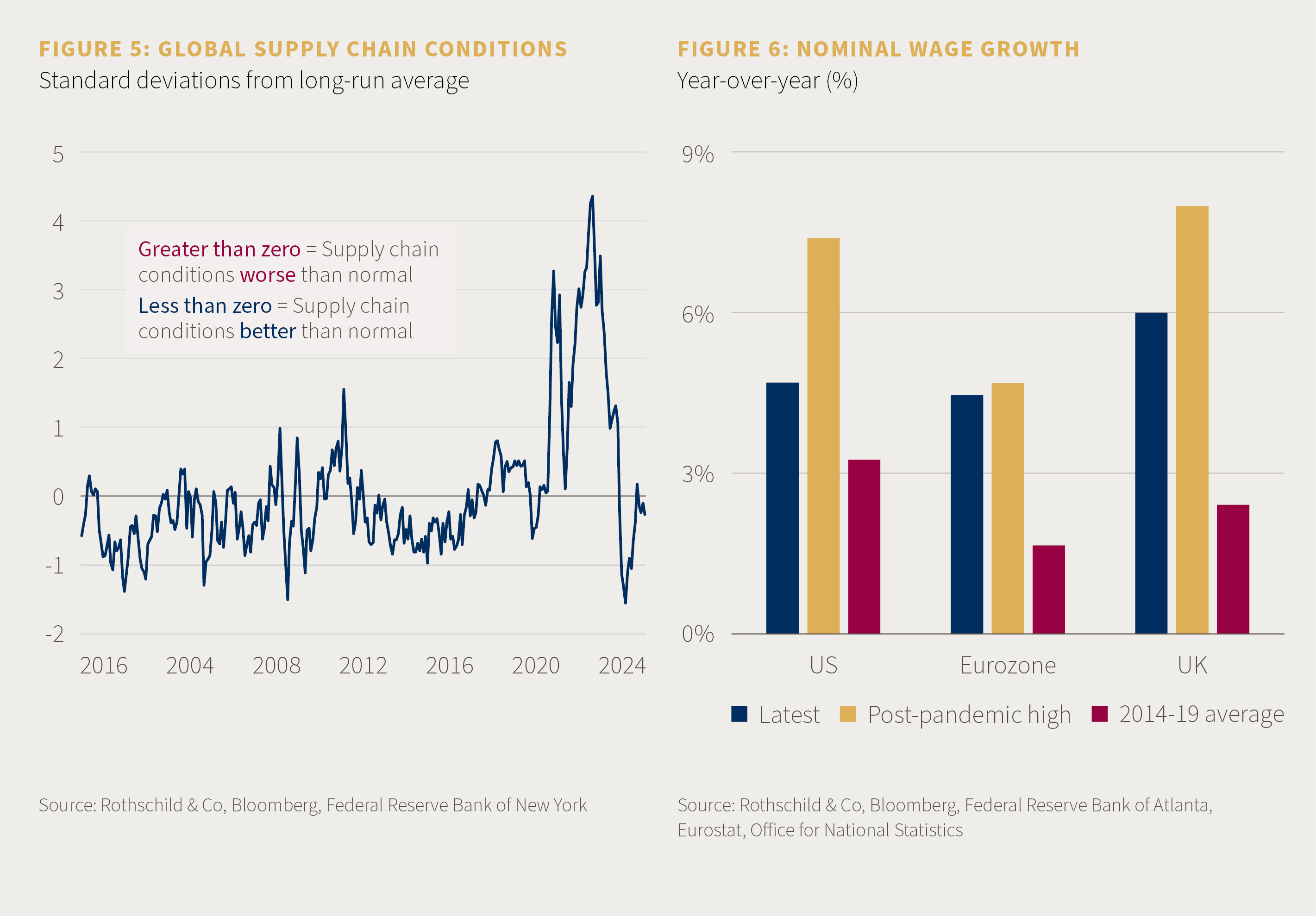
Services inflation yet to come unstuck
Services CPI inflation is being watched by central bankers most closely. It is not just the biggest component in the CPI, but also the stickiest. There are even signs it has re-accelerated in some parts of the world.
Nonetheless, there is reason to believe that they will continue to trend lower this year. That’s because nominal wage growth, the single biggest service sector input, has been cooling (Figure 6), though the descent to pre-pandemic rates is likely to be gradual given the persistence of tight labour markets.
Moreover, some services inflation may simply be lagging current market conditions. US shelter CPI inflation, a gauge of house and rent price costs, is a good example. It captures average costs across the housing stock over the past twelve months, rather than the cost of the latest month’s transactions alone, and so tends to lag real-time price developments by roughly a year. Shelter is in fact having a large impact on US inflation as it accounts for more than a third of the entire CPI basket.
Conclusion: Inflation to remain above target for now
Overall, the risks to inflation do seem more evenly balanced now: inflation rates have fallen a long way. A sustained fall below 2% still seems too optimistic; equally, a 1970s-style inflationary wave looks overly pessimistic. We continue to see developed world CPI inflation settling in the 2-4% range for a while longer yet.
The last mile is often the slowest.
Are governments living beyond their means?
A decade ago, it might have taken a year for the US to accumulate $1tn of debt. It has just done that in the past five months, taking outstanding federal debt to $35tn. It’s not just the US Treasury which has been spending briskly: most governments across the G7 have been running substantial budget deficits. The net debt/GDP ratio for advanced economies has expanded to 82% of GDP today.
A big contributor to recently-expanding US debt was pandemic-related spending. But with interest rates remaining higher for longer, and deficits elevated, there is growing fear that the debt burden is on an exponential trajectory. Last August, the credit rating agency, Fitch, took the decision to relieve the US of its coveted AAA rating (the second rating agency to do so) and more recently the IMF suggested that its debt might threaten financial stability.
Talk of a fiscal reckoning is mounting.
A national debt, if it is not excessive, to us will be a national blessing.
US in focus
Debt is a complicated and divisive topic. But as we see it, the US debt burden is challenging, but manageable.
According to the Congressional Budget Office (CBO), the US fiscal watchdog, US net federal debt is poised to hit 99% of GDP this year, and the budget deficit is expected to remain close to 6% of GDP. Potentially more concerning, however, are the CBO’s long-term projections, which suggest debt could rise to 166% of GDP by 2054 – with the budget deficit rising to 8.5% of GDP by 2054 (against a post-1962 average of 3%). Much of this projected deficit is driven by rising interest costs (currently ~3% of GDP today), but higher entitlement spending (such as Medicare and social security) account for most of the primary deficit. Importantly, these estimates assume that real growth will average 1.7% over the next three decades.
But such long-range forecasts can be misleading. Growth, interest rates, tax receipts and welfare spending are all hugely important, but very difficult to predict accurately. Small changes to assumed borrowing costs and prospective growth rates, projected over long-time horizons, can radically tilt those forecasts in either direction (as we noted some months back in the case of a long-term projection for the UK by the Office for Budget Responsibility).
For example, only a year ago, the CBO was projecting that US GDP would be flat in 2023, year one of their forecast: in the end, the outturn was an above average 2.5% growth rate. Even modest revisions to the CBO’s long-term assumptions over the past twelve months – growth revised upwards (from 1.6% to 1.7%) and the primary budget deficit revised downward – has shaved 30 (30!) percentage points off the projected debt to GDP ratio in three decades’ time (Figure 7).
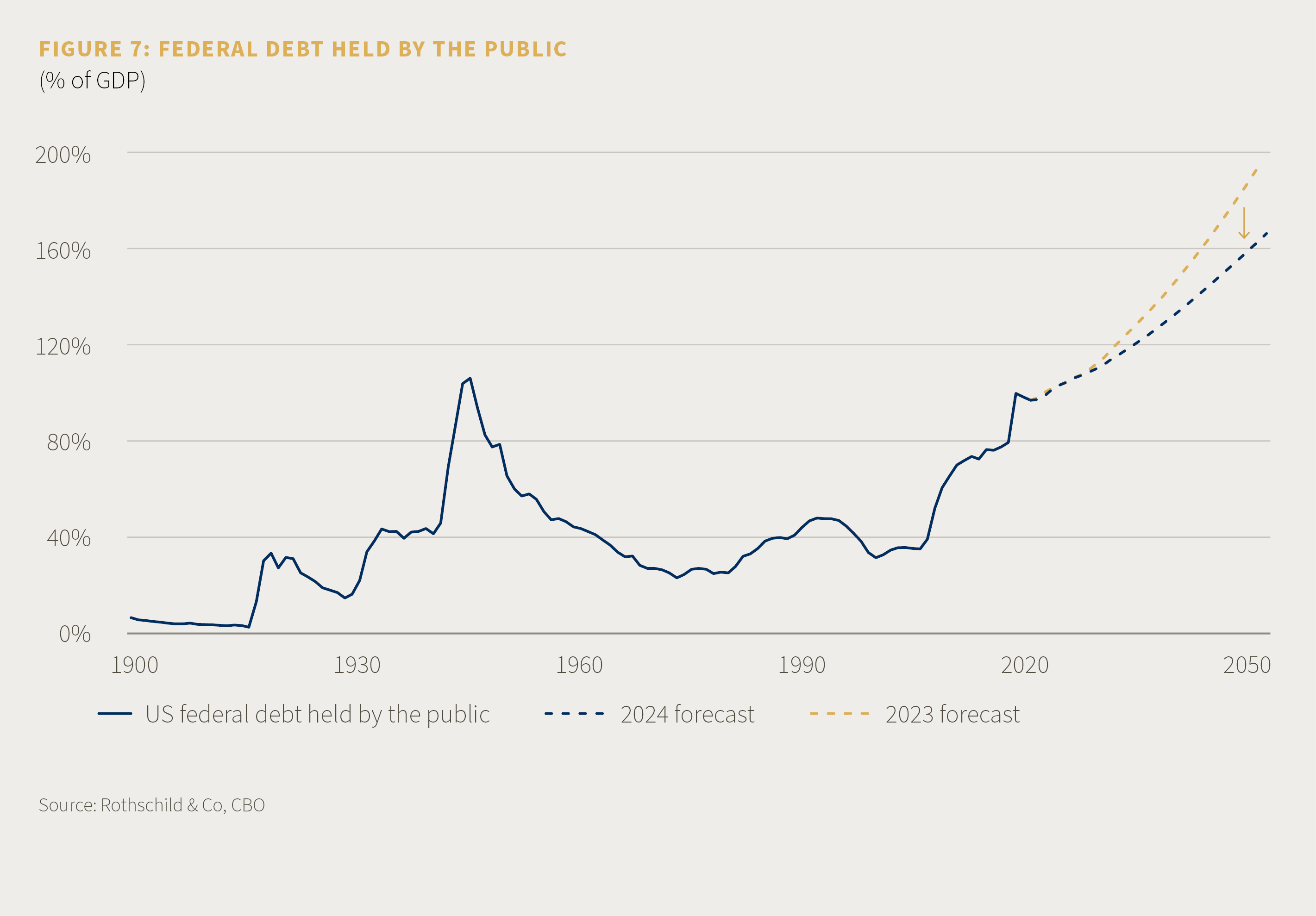
And if a US administration were ever to decide to tackle debt directly, the US could add several percentage points of GDP to its total tax take and still be a “low tax” economy: the wider OECD group is taxed more highly to begin with. Admittedly, any immediate attempt at austerity – cutting public spending and raising taxes – is unlikely to be a winning election strategy.
The distinction between headline and structural deficits can be important. The former reflects fluctuations in short-term growth, while a structural deficit shows the 'underlying' (or trend) budget position regardless of the business cycle. Most countries have structural as well as headline deficits, but the gap can sometimes be large, as it is today. The US has not balanced its budget on a headline basis since the Clinton administration, but even structural budget deficits can be manageable if economic growth exceeds the growth of debt. Ronald Reagan arguably had a point when he quipped, "I am not worried about the deficit. It is big enough to take care of itself."
Growth affects debt, then – but it is not clear when the level of debt itself starts to affect the economy's sustainable rate of growth. Various ‘critical’ debt thresholds have been posited – ranging from little as 75% to 90% (on a gross basis, Rogoff/Reinhart) – at which the debt arithmetic begins to constrain the economy.
Poor countries do often have large debt burdens, but often their low growth is related to deep-seated structural issues – such as lack of natural resources, excessive regulation, labour market inflexibility, a lack of innovation and investment. In the right context, debt is often tolerated: fiscal policy that stimulates infrastructure and private investment can boost productivity and raise output – the aim of the Inflation Reduction Act’s climate related subsidies.
The US also enjoys a unique position globally. It is the world’s largest economy, with the deepest and most important capital market, and the global reserve currency. Even without central bank buying, international investors are still hungry for credible (that is, high quality) investment income and a store of value – and US Treasuries are still seen as providing just those things, even today.
Can a reckoning be avoided?
Government creditworthiness and fiscal stance vary over time, and of course across countries. Germany’s fiscal frugality, for example, marks a stark contrast to Italy’s more challenging debt. But there is little sign that the bond vigilantes are revolting against signs of perceived profligacy (the UK’s mini-budget crisis in late 2022 is perhaps one exception, though that crisis was very much one of the then government’s own making). But while Italy does have relatively high bond yields compared to Germany, those yields do not often seem to correlate with its shifting fiscal fortunes. And Japan, which has had one of the biggest developed world debt ratios for several decades (net debt currently is close to 160% of GDP), has consistently enjoyed some of the lowest bond yields in nominal terms, and even in real terms its yields have not been remarkable.
We see recently-rising yields on US and other government bonds – and spreads on peripheral eurozone bonds – as largely reflecting macroeconomic developments. When pandemic deficits were at their highest, government yields were close to their lowest.
For a final constructive note, we turn – perhaps unexpectedly – to the IMF, whose current forecasts suggest that on a five year view most government debt burdens will fall from their current levels – admittedly, with some support perhaps from above-trend inflation (Figure 8).
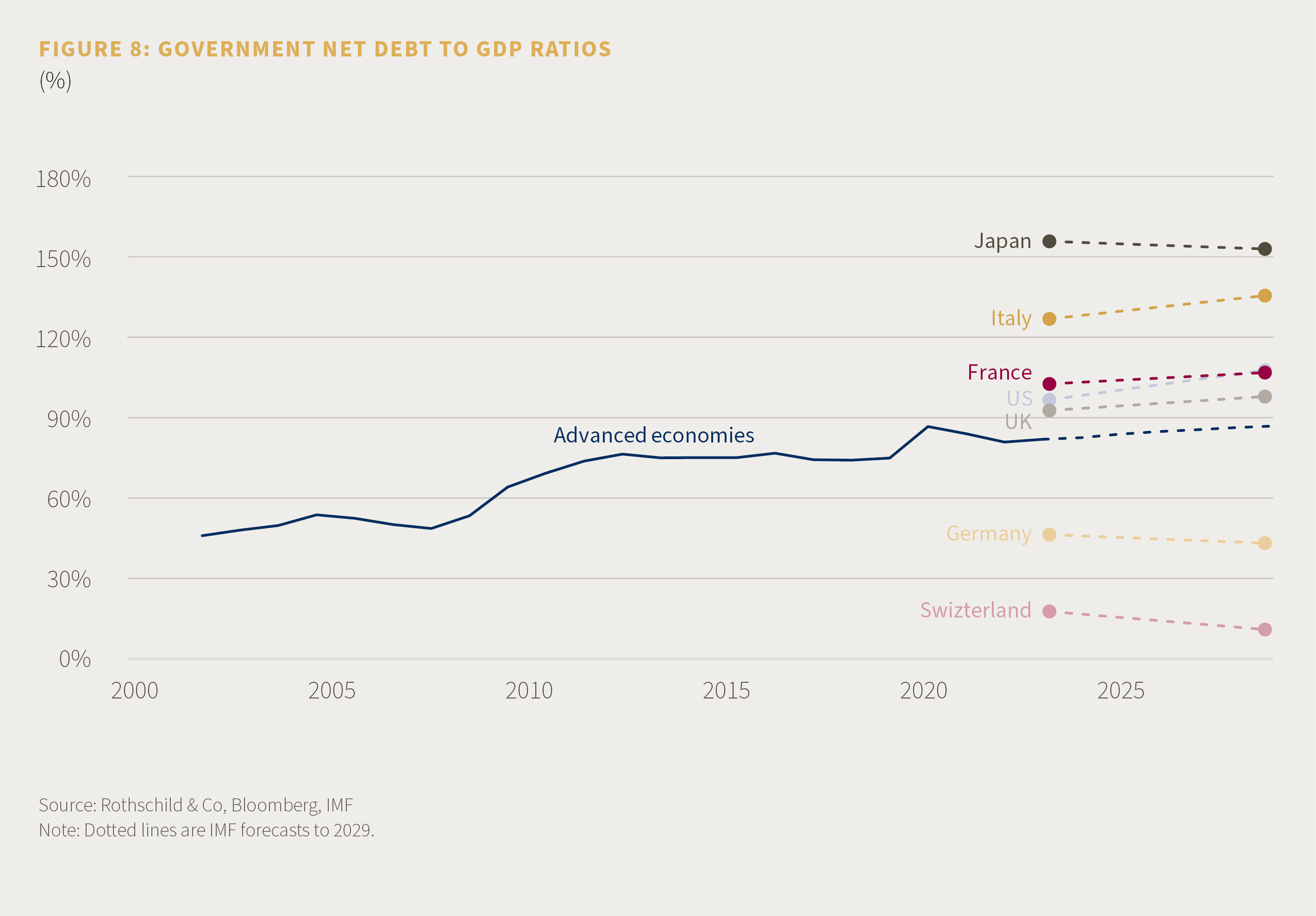
Conclusion? In this, as with many other macro concerns, our inclination is to avoid the temptation to say that disaster is inevitable: it usually isn't. That said, our belief that the creditworthiness of the US government is relatively low on the list of things to worry about doesn’t mean that the next occupant of the Oval Office will not face some important fiscal challenges.
We see recently-rising yields on US and other government bonds – and spreads on peripheral eurozone bonds – as largely reflecting macroeconomic developments.
Past performance is not a guide to future performance and nothing in this blog constitutes advice. Although the information and data herein are obtained from sources believed to be reliable, no representation or warranty, expressed or implied, is or will be made and, save in the case of fraud, no responsibility or liability is or will be accepted by Rothschild & Co Wealth Management UK Limited as to or in relation to the fairness, accuracy or completeness of this document or the information forming the basis of this document or for any reliance placed on this document by any person whatsoever. In particular, no representation or warranty is given as to the achievement or reasonableness of any future projections, targets, estimates or forecasts contained in this document. Furthermore, all opinions and data used in this document are subject to change without prior notice.
Ready to begin your journey with us?
Speak to a Client Adviser in the UK or Switzerland







